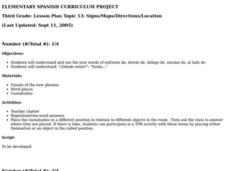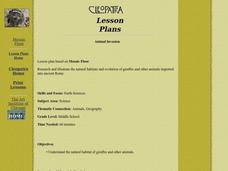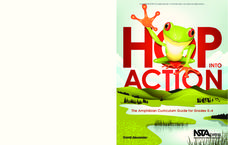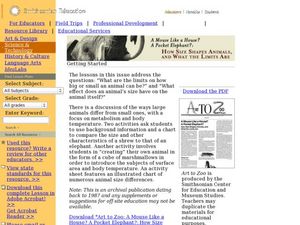Curated OER
Comparing Mitosis with Meiosis
Life science learners view an online animated mini textbook comparing two types of cell division. Working in groups, they use a digital microscope to capture images of cells in different stages of mitosis and meiosis. Then they create an...
Curated OER
Ocean Streams
The instructions for demonstrating ocean turnover are provided in this resource. You could set this up for your earth science class as part of a lecture on convection currents or as an explanation of how ocean currents form. An animation...
Curated OER
Simple Directions
Where is it? Place a favorite classroom object (a stuffed animal perhaps) around the room and have your young language learners give you directions to find it. They have to tell you whether you should go straight, turn right, etc....
Curated OER
Caught in a Net
Students read and discuss the bycatch of the sea and the economic impact of taking bycatch away. In this bycatch lesson plan, students discuss the rights of fisherman and observe pictures of sea animals.
Indiana Historical Society
Lesson One – Vietnam War Time Line
To prepare for an in-depth study of the Vietnam Era, class members research and create a timeline that tracks the United States' involvement in Southeast Asia and especially Vietnam.
Curated OER
Undercover in the Secret State
Learners examine the current conditions in North Korea. They view and analyze a CNN documentary, research a dissident, answer and discuss questions about the documentary on conditions in North Korea, and identify the technology used by...
Curated OER
Animal Invasion
Young scholars research and illustrate the natural habitats and evolution of giraffes and other animals imported into ancient Rome. They draw a map of Europe, North Africa, and West Asia and draw the animals from each region in their...
Curated OER
Baby Animals
Learners study baby penguins and whales. They name the penguin body parts and examine how penguins hatch from eggs. They name whale body parts and their function. They participate in a whale role play activity.
National Science Teachers Association
Hop into Action
Young scientists find out what makes amphibians such unique and interesting animals in this simple life science lesson plan. After looking at pictures and discussing the characteristics of amphibians, learners complete a...
Maryland Department of Education
Our Children Can Soar
Amazing efforts of African American leaders are celebrated in a instructional activity on civil participation. The engaging resource focuses on primary and secondary sources to analyze the impact of African American leaders such as Ella...
EngageNY
Using Informational Text Features and Learning Freaky Frog Vocabulary
What kind of text features help children build a strong vocabulary? Class members use text features such as headers to unpack new vocabulary words. They create vocabulary journals in which they will write what they think the definition...
NASA
The Case of the Wacky Water Cycle
Join the tree house detectives in learning about the processes of the water cycle, water conservation, water treatment, and water as a limited resource.
Channel Islands Film
Island Cattle Ranching
Is cattle ranching on Santa Rosa island viable or non-viable? Rather than focusing on the issues of the transition of Santa Rosa island from a privately owned island cattle ranch to a national park, class members are asked to consider if...
Curated OER
Forest Animals
Students explore forest animals and their habitats. In this animal habitat lesson, students draw a forest on white paper and glue pictures of animals that roam in the forest
Curated OER
Safari Sentence Scramble
Students use real life experiences for writing. In this identifying details lesson, students use information such as colors, numbers, sizes, shapes and locations to write sentences about the zoo. Students position the words from...
Curated OER
We're Zoologists!
Students listen to story, "Never, Ever Shout in a Zoo," by Karma Wilson, practice finding information from Internet, write information about one chosen zoo animal, draw picture of their zoo animal, pair up and read their My Zoo Animal...
Curated OER
Biology: Understanding Cellular Organelles
Learners distinguish the differences between Prokaryotic and Eukaryotic cells. Using microscopes, they examine a variety of plant and animal cells. Working in groups, they draw and label plant and animal cells and show the mathematical...
Curated OER
How Size Shapes Animals
Students investigate how size affects large and small animals differently. In this animal lesson plan, students determine how size affects different animals by constructing their own animal out of marshmallows. Once students create...
Curated OER
What Makes a Tropical Rainforest Special?
Students examine the characteristics of the tropical rainforest. Using a map, they locate the rainforests found around the world, continents and the equator. Using the internet, they research the various layers of the rainforest and...
Curated OER
How Much Land Does It Take To Produce Your Food?
Young scholars calculate the amount of land required to produce the food eaten by an individual for one year. They compare the amount of land required to produce animal versus plant products. Students visualize the areas of land...
Curated OER
Hatched From An Egg
Students discover how animals are born/hatched. In this life science lesson plan, students listen to a book entitled Chickens Aren't The Only Ones, and discuss animals that are hatched or born. Students receive a picture of an...
Curated OER
When Turtle Grew Feathers
Young scholars explore the Choctaw Native American tribe. For this cross curriculum literacy and U.S. history lesson, students locate where the Choctaw Indians lived on a United States map. Young scholars listen to When...
Curated OER
Respect for Animals
Students discuss importance of acting responsibly when caring for pets, reflect upon quote, "All Living Beings Have the Right to Respect and Kindness," read story Anastasia Wants a Rabbit and answer comprehension questions, role play...
Curated OER
Who Let the Dogs Out Tag/Dance
Learners get a stuffed animal (chicken, dog or rabbit). When the "Bunny Hop" music is playing, all students perform the dance. When "Who Let the Dogs Out" plays, the "dogs" chase (via walking) the chickens and rabbits. If tag
Other popular searches
- Animal Rights Zoo
- Activity on Animal Rights
- Animal Rights Issues
- Animal Rights and Elephants
- Animal Rights Lesson Plan
- Animal Rights Animal Welfare
- Animal Rights for Cougars
- Animal Rights and Religion
- Animal Rights and Teachers
- Animal Rights in Thailand
- Animal Rights and Buddhism
- Animal Rights Circus























